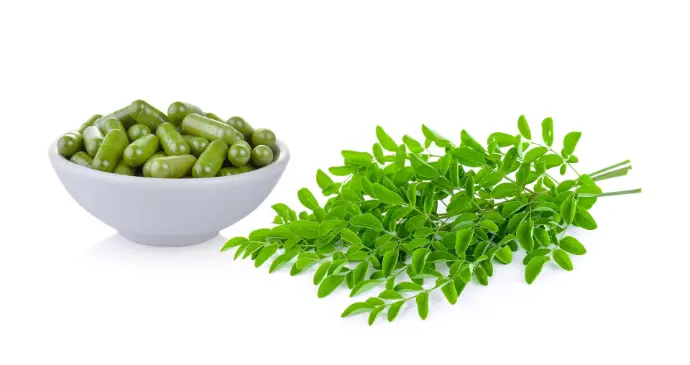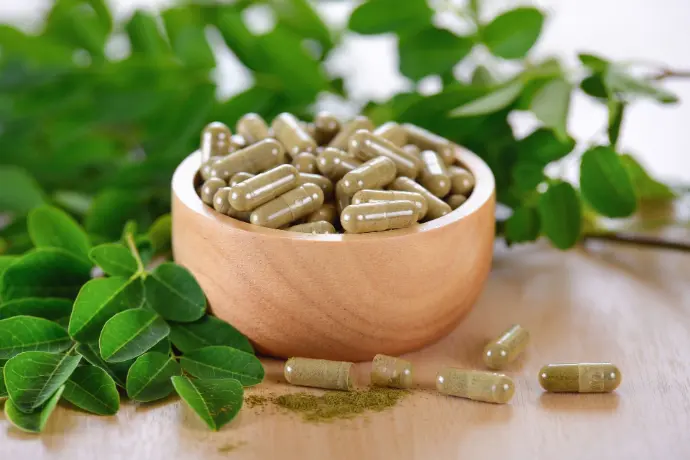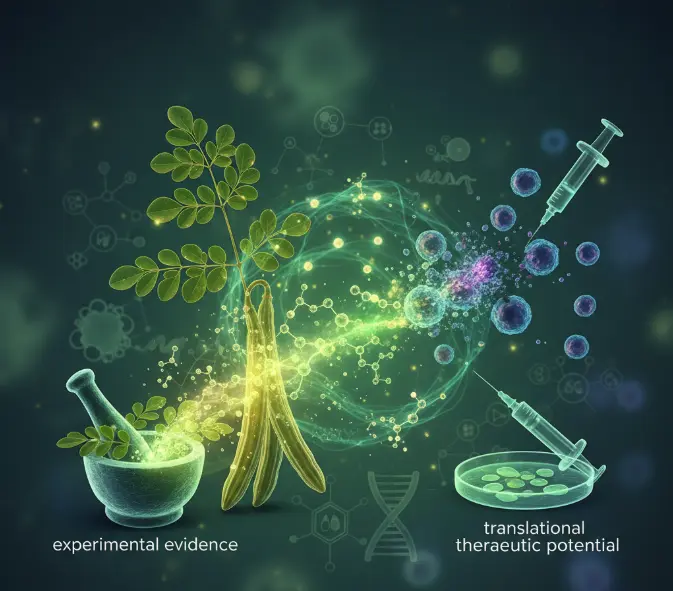Moringa oleifera sometimes called the “miracle tree” has attracted a lot of scientific attention for its rich content of bioactive compounds and its potential health benefits. One of the most promising areas of research is its anti-cancer (anticarcinogenic) activity. Below, I break down what we know recently about the phytochemicals in Moringa oleifera, how they may act against cancer, and what the current evidence suggests.
Phytochemicals in Moringa oleifera
Moringa oleifera is rich in a wide variety of secondary metabolites, many of which are believed to contribute to its medicinal properties, including anti-cancer effects. The main groups and representative compounds include:

Flavonoids and polyphenols
- For example: quercetin, kaempferol, rutin, chlorogenic acid, gallic acid, caffeic acid, 4-hydroxy-3-methoxy cinnamic acid, p-coumaric acid, sinapic acid, vanillic acid, etc.
- These compounds are well known for antioxidant, anti-inflammatory, and free radical scavenging properties.

Isothiocyanates and glucosinolates
- E.g. niazimicin, niazimicin A, niazimicin B, 4-(α-L-rhamnosyloxy) benzyl isothiocyanate, among others.
- These are especially interesting because they tend to interfere with cellular signalling related to detoxification, apoptosis, and cell proliferation.

Carotenoids, phytosterols, and other minor constituents
- Carotenoids (e.g. β-carotene) and sterols (e.g. β-sitosterol) have also been identified in leaves and seeds.
- These compounds can contribute to antioxidant capacity and modulating lipid-based pathways

Other bioactives
- Includes alkaloids, proteins/peptides, and additional minor phenolic and non-phenolic compounds.
- The overall “cocktail” of many compounds may act synergistically, not just one single molecule.
Mechanisms of action: How Moringa oleifera phytochemicals may fight cancer
Antioxidant & anti-inflammatory effects
By neutralizing reactive oxygen species (ROS), Moringa compounds reduce DNA damage and oxidative stress, which are linked to mutation and cancer initiation.
Also chronic inflammation is a known cancer-promoting environment; Moringa helps modulate inflammatory signalling.
Induction of apoptosis and cell cycle arrest
Several studies show that Moringa oleifera extracts induce programmed cell death (apoptosis) in cancer cells, via increased caspase activity, cleavage of PARP, upregulation of p53, and other related pathways.
There's also evidence of cell cycle arrest (e.g. at G0/G1 or G2/M phases), reducing proliferation.
Anti-angiogenesis, metastasis inhibition, and immunomodulation
There is evidence (especially from animal and pre-clinical studies) that Moringa can reduce the formation of new blood vessels in tumors, limit spread (metastasis), and positively influence immune responses.
These effects are still being explored, but they expand the utility beyond cytotoxicity alone.
Inhibition of pro-survival and proliferation signalling
Some phytochemicals from Moringa can bind to and inhibit proteins that help cancer cells survive. For example, a recent computational study showed multi-ligand simultaneous docking of several Moringa compounds against BCL-2 (an anti-apoptotic protein) with strong binding affinities, sometimes better than a commercial BCL-2 inhibitor (Venetoclax).
Other pathways like JAK/STAT (e.g. in non-small-cell lung cancer) are also inhibited, leading to reduced proliferation, angiogenesis, and metastasis.

Recent experimental evidence & findings
Molecular docking & synergistic action
A study (“Multi-Ligand Simultaneous Docking Analysis …”) tested multiple leaf phytochemicals of Moringa against BCL-2.
They found that compounds like niazinin, α-carotene, hesperetin, apigenin, niaziminin B, and niazimicin A showed high binding affinities, sometimes exceeding Venetoclax.
More interestingly, when these compounds were docked together (simultaneously), they exhibited synergistic interactions that increased binding affinity, suggesting that combined effects may be stronger than individual compounds.
Oral squamous cell carcinoma systematic review
A recent review of works (in vitro, in vivo, molecular studies) on oral squamous cell carcinoma found that Moringa oleifera extracts (of various parts) consistently showed antioxidant, anti-inflammatory, antiproliferative, and chemopreventive properties.
While promising, the review notes that more clinical trials are needed to establish safety, efficacy, and dosage in humans.
Liver cancer (hepatocellular carcinoma) study
One paper (Malaysian Journal of Fundamental and Applied Sciences) used GC-MS and LC-HRMS to profile seed oil and leaf powder phytochemicals and then performed molecular docking related to TGF-β1, a key factor in liver fibrosis and HCC. They found strong interactions, suggesting Moringa derivatives could help in early liver cancer/fibrosis stages.
Phenolic compounds against HeLa (cervical cancer) cells
A study assessed different solvent fractions of Moringa leaves, identified several phenolic acids and flavonoids via RP-HPLC, then tested them in vitro for cytotoxic activity. They also performed molecular docking and found good binding energies with cancer-related targets.
Their results support the idea that these phenolics can inhibit cancer cell growth, though at relatively high concentrations, and suggest further development is needed.
Breast cancer antiproliferative potential
There’s a recent publication reviewing how Moringa oleifera extracts affect breast cancer cells, showing in several studies that they slow proliferation, induce apoptosis, and may help overcome resistance.
Practical considerations & limitations
In vitro or animal vs human clinical evidence
Most studies to date are in vitro (cell lines) or in vivo (animal models). There is a lack of robust human clinical trials, which are needed to translate these findings into real therapies.
Dosing, bioavailability, metabolism, safety, and interactions in humans remain underexplored.
Synergy vs single compounds
The synergistic effects (multiple compounds working together) are an exciting aspect, but also complicate development: isolating, standardizing, and regulating mixtures is more challenging.
Extraction method and phytochemical variability
The effectiveness depends heavily on how the plant material is processed (which solvent is used, which part of the plant, fresh vs dried, etc.). Different varieties or growth conditions yield different phytochemical profiles.
For example, one study showed that different M. oleifera varieties had varied amounts of quercetin, kaempferol, moringin, etc., impacting anticancer activity.
Bioavailability, delivery, and safety
Even if a compound shows strong activity in vitro, it may not reach the target in the body at effective concentration due to poor absorption, rapid metabolism, or elimination.
Potential toxicity, side effects, or interactions with existing cancer therapies are concerns that must be addressed. Reviews point out that Moringa is generally safe, but data are limited.
Synergy vs single compounds
The synergistic effects (multiple compounds working together) are an exciting aspect, but also complicate development: isolating, standardizing, and regulating mixtures is more challenging.






